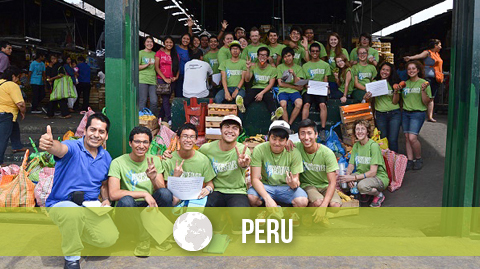GPA Serves in Peru
These past few weeks we have been featuring Generation Peace Academy’s (GPA) overseas service projects in Panama, the Dominican Republic and the Philippines. This week’s final feature will highlight a group of 25 GPA participants who recently returned from three weeks of service in Peru. With the support of Peruvian FFWPU members and under the leadership of GPA Director Roland Platt, these young men and women completed beautification and renovation projects in Lima, helped to build an orphanage in Arequipa, and supported the construction of a church building near Lake Titicaca.
According to Seyoung Nakama, a first-year GPA participant, “It was amazing to see how crowded the houses were. There were dirt roads, and the houses were flimsy. They put them together quickly. Some looked better than others, but most had to make do with what they had. To them, the conditions were normal. It was eye-opening compared to what we have [in the United States].”
In Lima, the capital, the stark contrast between the developing city center and surrounding slums is evident. GPA began its service work by doubling the size of a community center in Huaycan, a community on the outskirts of the city, and clearing and constructing stairs in the slums of Chorillos. GPA also painted and repaired a playground, cleaned an orphanage, and sold fruit to raise funds for Peru’s only senior citizen community center, called El Asilo de Ancianos Virgen de Carmen.
After five days in Lima, the GPA participants rode a bus for 16 hours to reach the southern city of Arequipa, where they embarked on the second phase of their service work. They first helped reconstruct a fence and roof for a preschool on the outskirts of this previously Spanish-controlled colonial city. The preschool, which is attended by 24 neighborhood children, was surrounded by a fence that was not strong enough to keep the children inside. In addition, the roof leaked, causing damage to school supplies when it rained.
GPA subsequently visited an orphanage, Casa Hogar Luz Alba, and helped level the ground and prepare the walls for the construction of a larger building. Founded in 1950 by an 18-year-old orphan, Samuel Aun Weor, it can house a maximum of 20 orphans. The new building that GPA helped construct will be able to hold around 50 orphans.
The next phase of work took place in the southeastern city of Puno on the shore of the famous Lake Titicaca, where GPA spent three days leveling the ground for a new church that the Puno FFWPU community is constructing in the shape of the unification symbol. Due to the high altitude of 12,000 feet, the volunteers easily lost their breath as they shoveled dirt, pushed a wheelbarrow, or used a pickax. The construction site managers divided everyone into three groups to work in rotation.
It was definitely a challenge, but “whenever I looked up at the sky, my only thought would be ‘God is so good.’ Seeing God’s creation, the mountains, condors, alpacas, and my brothers and sisters work together in harmony brought me so much joy. … At times we were tired physically and emotionally, but seeing my brothers and sisters work so hard to make someone else’s job easier was so beautiful,” stated first-year Janaina Ochoa.
The last workday was spent cleaning up around Lake Titicaca, the largest lake in South America, and raising awareness about caring for the lake. Many of the locals throw trash into it and even use it as a bathroom. The mayor of Puno came with his son to inform the group about the condition of the lake and the need to spread such awareness. The GPA participants also spent some time playing sports with local Collegiate Association for the Research of Principles (CARP) students, who also pitched in at the lake cleanup.
Throughout the trip, GPA volunteers were exposed to the diverse geography, cultures, and church communities of Peru, as well as the local cuisine. For example, they sampled ceviche, seasoned raw fish; lomo saltado, a meat and potatoes dish; and cuy (guinea pig), which is considered a delicacy in Peru. The group also visited a number of historical sites associated with the ancient Incan people, such as the Museo Oro Del Peru in Lima, and Moray, Chinchero, and Ollantaytambo in the southeastern city of Cusco. In addition, GPA witnessed some spectacular sights in Colca Canyon and traveled to three different islands: Isla de Uros (the floating islands), Taquile and Amantani, where they stayed with local residents.
GPA volunteers learned many new things about life through these experiences. “What I’ve learned is that everyone can feel God’s joy, no matter what kind of situation they are in; that’s what makes us God’s children and equal. No matter who you are or what kind of material possession they have or not, anyone can gain happiness,” reflected second-year participant Takafumi Nomura.
Whether through working hard at their service projects, trying to communicate in Spanish, or bringing smiles to children and senior citizens through song and dance, the GPA participants undoubtedly left a lasting impact in the communities that they visited. First-year participant Joshua Holmes said: “It wasn’t only the physical work we did for the communities, but also how we worked together for a higher purpose. We came together as one family. We were able to leave Peru feeling God’s heart and love within us.” This is how life should always be, leaving behind an impact of love.

